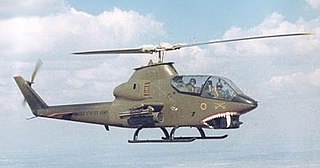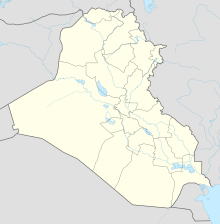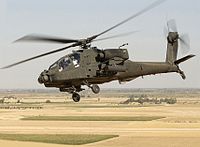
The Bell AH-1 Cobra is a single-engined attack helicopter developed and manufactured by the American rotorcraft manufacturer Bell Helicopter. A member of the prolific Huey family, the AH-1 is also referred to as the HueyCobra or Snake.

The Boeing AH-64 Apache is an American twin-turboshaft attack helicopter with a tailwheel-type landing gear and a tandem cockpit for a crew of two. Nose-mounted sensors help acquire targets and provide night vision. It carries a 30 mm (1.18 in) M230 chain gun under its forward fuselage and four hardpoints on stub-wing pylons for armament and stores, typically AGM-114 Hellfire missiles and Hydra 70 rocket pods. Redundant systems help it survive combat damage.

The Iraqi Republican Guard was a branch of the Iraqi military from 1969 to 2003, which existed primarily during the presidency of Saddam Hussein. It later became known as the Republican Guard Corps, and then the Republican Guard Forces Command (RGFC) with its expansion into two corps. The Republican Guard was disbanded in 2003 after the invasion of Iraq by a U.S.-led international coalition.

The 160th Special Operations Aviation Regiment (Airborne), abbreviated as 160th SOAR (A), is a special operations force of the United States Army that provides helicopter aviation support for special operations forces. Its missions have included attack, assault, and reconnaissance, and these missions are usually conducted at night, at high speeds, low altitudes, and on short notice.

An attack helicopter is an armed helicopter with the primary role of an attack aircraft, with the offensive capability of engaging ground targets such as enemy infantry, military vehicles and fortifications. Due to their heavy armament they are sometimes called helicopter gunships.

The Bell AH-1 SuperCobra is a twin-engined attack helicopter that was developed on behalf of, and primarily operated by, the United States Marine Corps (USMC). The twin Cobra family, itself part of the larger Huey family, includes the AH-1J SeaCobra, the AH-1T Improved SeaCobra, and the AH-1W SuperCobra.

The AgustaWestland Apache is a licence-built version of the Boeing AH-64D Apache Longbow attack helicopter for the British Army Air Corps. The first eight helicopters were built by Boeing; the remaining 59 were assembled by Westland Helicopters at Yeovil, Somerset in England from Boeing-supplied kits. Changes from the AH-64D include Rolls-Royce Turbomeca RTM322 engines, a new electronic defensive aids suite and a folding blade mechanism allowing the British version to operate from ships. The helicopter was initially designated WAH-64 by Westland Helicopters and was later given the designation Apache AH Mk 1 by the Ministry of Defence.

The Battle of Medina Ridge was a tank battle fought on the 27 February 1991, during the Gulf War, between the U.S. 1st Armored Division and the 2nd Brigade of the Iraqi Republican Guard Medina Luminous Division outside Basra, Iraq. The U.S. 3rd Brigade, 3rd Infantry Division, was also a major contributor, by leading the attack. Iraq's Adnan Motorized Division was also a participant. Medina Ridge is the name American troops gave to a low rise, approximately seven miles (11 km) long.

The Battle of Norfolk was a tank battle fought on February 27, 1991, during the Persian Gulf War, between armored forces of the United States and United Kingdom, and those of the Iraqi Republican Guard in the Muthanna Province of southern Iraq. The primary participants were the U.S. 2nd Armored Division (Forward), 1st Infantry Division (Mechanized), and the Iraqi 18th Mechanized and 9th Armoured Brigades of the Republican Guard Tawakalna Mechanized Infantry Division along with elements from eleven other Iraqi divisions. The 2nd Armored Division (Forward) was assigned to the American 1st Infantry Division as its 3rd maneuver brigade due to the fact that one of its brigades was not deployed. The 2nd Armored Division (Forward)'s Task Force 1-41 Infantry would be the spearhead of VII Corps. The British 1st Armoured division was responsible for protecting the right flank of VII Corps, their main adversary being the Iraqi 52nd Armored Division and multiple infantry divisions. It was the final battle of the war before the unilateral ceasefire took effect.

The Combat Aviation Brigade, 1st Cavalry Division is a divisional aviation brigade of the United States Army. It was activated on 16 September 1984.

The 1st Battalion, 227th Aviation Regiment is an attack helicopter battalion of the Combat Aviation Brigade, 1st Cavalry Division. The battalion is an AH-64 Apache battalion based at Fort Cavazos, Texas.
The 229th Aviation Regiment is an aviation unit of the United States Army.

The Battle of Karbala took place during the 2003 invasion of Iraq as U.S. troops fought to take control of the city from Iraqi forces. The city had been bypassed during the advance on Baghdad, leaving American units to clear it in two days of street fighting against Iraqi Saddam Fedayeen Irregular forces.

The Battle of Najaf was a major battle in the 2003 U.S. invasion of Iraq. The first stage of the battle was fought when the U.S. 3rd Infantry Division fought to surround the town. The second stage was fought when soldiers from the U.S. 101st Airborne Division fought to clear and secure the city.

The 159th Combat Aviation Brigade (CAB) formerly supported the 101st Airborne Division, and was stationed at Fort Campbell, Kentucky. While active, 159th CAB made the 101st Airborne Division the only US Army Division with two organic aviation brigades, and currently the 101st CAB is the only CAB supporting the unit at Fort Campbell. The 159th CAB was inactivated on 15 May 2015.

The 1st Aviation Regiment is a task force and is a unit in the First Infantry Division's Combat Aviation Brigade, composed of three battalion units of pilots, crews, and teams within the United States Army.

The 3rd Aviation Regiment is a regiment of the United States Army Aviation Branch. It operates the Boeing AH-64 Apache attack helicopter, Sikorsky UH-60 Black Hawk helicopter, and Boeing CH-47 Chinook helicopter. It has been associated with the 3rd Infantry Division for some time.

3 RegimentArmy Air Corps is a regiment of the British Army and is part of the [[1 Aviation Brigade Combat Team|and Joint Helicopter Command,(JHC).3AAC is based at Wattisham Flying Station in Suffolk, England. This regiment operates the Apache AH Mk1 and AH-64E Apache attack helicopters.

The Battle of Al Hillah was an armed military confrontation between military elements of the United States and Iraq during the 2003 Invasion of Iraq. Prior to the Iraq War, the ancient city of Al Hillah was home to numerous bases for the Iraqi Medina division of the Iraqi Republican Guard. As a main objective of the invasion of Iraq was to disable the Republican Guard, this made Al Hillah an important target for Coalition forces, as well as the fact that Al Hillah lay in the path of the planned Coalition advance Najaf.




















